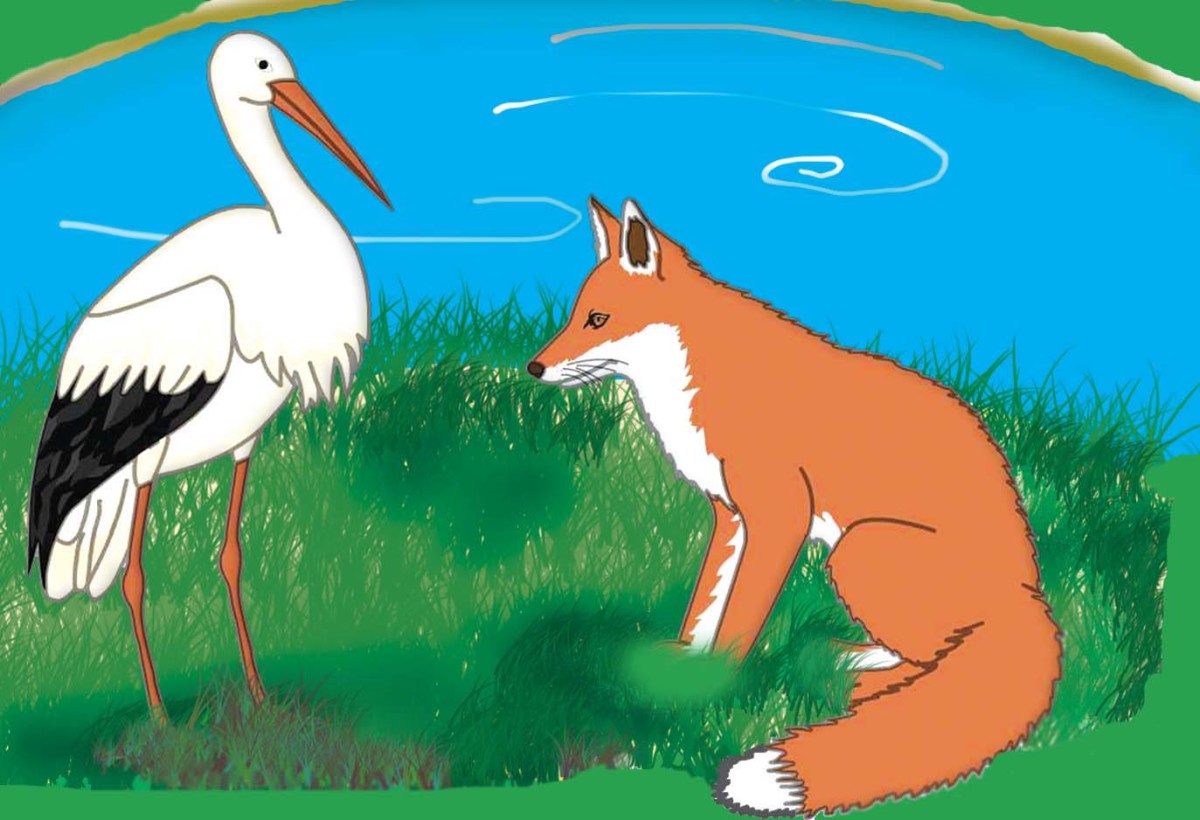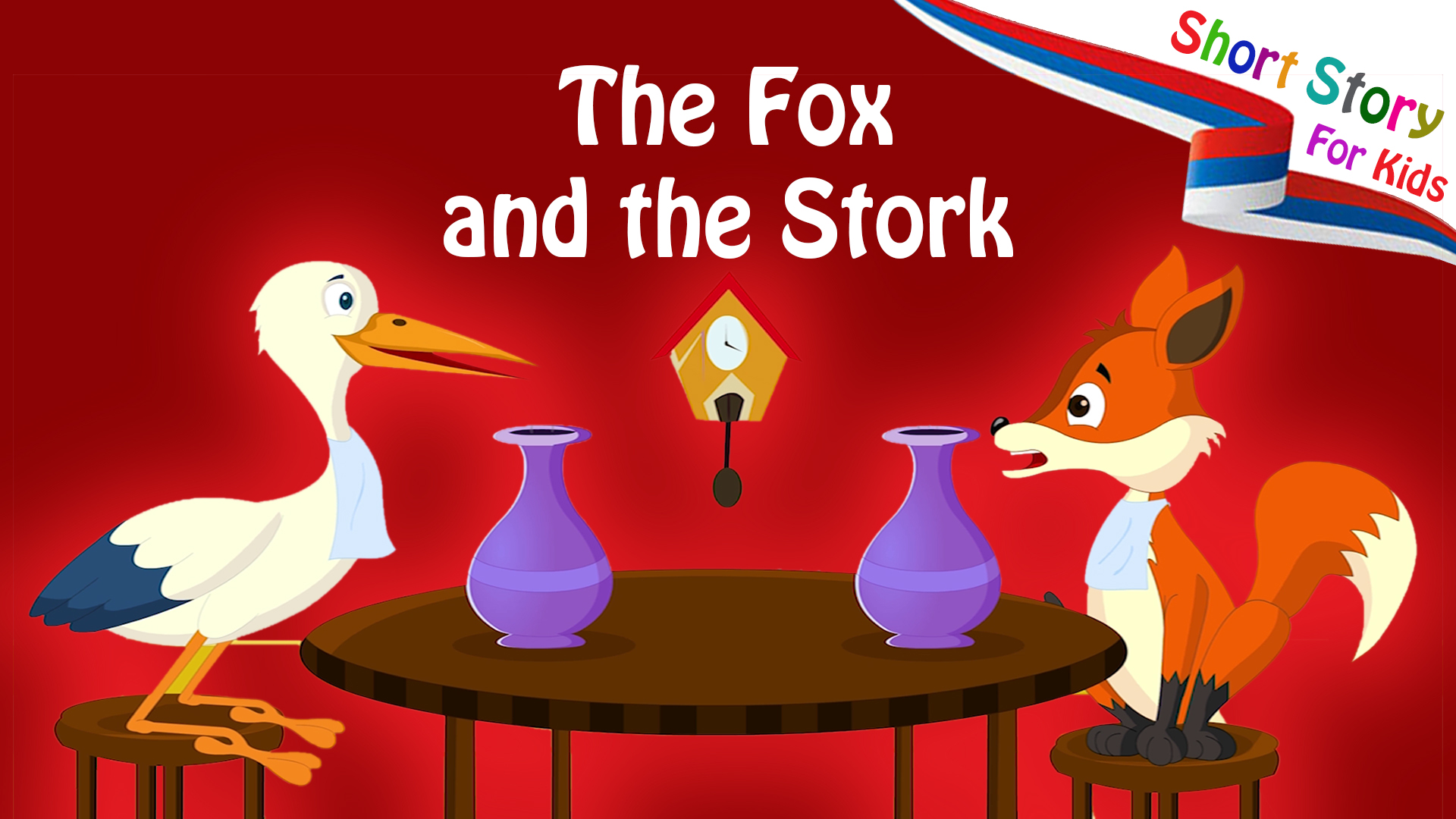The Fox and the Stork – Aesop’s Fables
“The Fox and the Stork” also known as “the fox and the crane” is a part of the Aesop Fables and is hence included into the Perry index. It is the story of how a wily and cunning fox plays tricks on everyone. He tricks a stork and the stork exacts its revenge.
If you want to read another thought provoking tale from the Aesop Fables, you can read The pitcher and the crow or The travellers and the plane tree.

Story
The fox is a very sly animal. He always wants to play tricks on every neighbor in the forest. The fox particularly loved making fun of the stork. In fact, he thought that the stork looked funny with its lock legs, long beak, long neck and small body. One day he thought of a brilliant plan.
“Ohhh. This trick is very funny. I must play this trick on the Stork”, the fox thought to himself.
He went to the Stork and pretended to be a good neighbor. The Fox said, “Hello, Mr Stork. I hope you are well, this fine morning.”
The Stork replied, “Why, I am very well Mr Fox, thank you so much for asking.”
The Fox smiled and said, “You must come home for dinner. I have caught a very tasty fish today morning. I wish to make and share a delicious bowl of fish soup with you.”
Mr. Stork was very pleased. “Definitely Mr. Fox. I shall see you at your home.”
The stork arrived to the home of the Fox with good hunger for he loved fish soup. They chatted for a while and the Fox saw that the Stork was getting hungry.
The Fox served the soup but in a very shallow plate. The stork had such a long beak that it could only wet the tip of its beak. He could not swallow a single drop of soup. Meanwhile, the Fox was loudly lapping away making loud sounds of happiness.
The Stork was a very calm and smart bird and did not want to start a fight with the Fox. There was no use of fighting with the Fox. He thanked the Fox for the meal and went home hungry.
The Fox and the CraneA few days later, the Stork called the fox. He went to the Fox and pretended to be a good neighbor.
The Stork said, “Hello, Mr Fox. I hope you are well, this fine morning.”
The Fox replied, “Why, I am very well Mr Stork, thank you so much for asking.”
The Stork smiled and said, “You must come home for dinner. I have caught a very tasty fish today morning. I wish to make and share a delicious bowl of fish soup with you.”
Mr. Fox thought about what had happened earlier but decided that the Stork was too dumb to play a trick on him. He said, “Definitely Mr. Stork. I shall see you at your home.”
The fox arrived to the home of the stork with good hunger for he too loved fish soup. They chatted for a while. The Stork waited until the Fox was very hungry.
The Stork served the soup but in a tall jar with a very narrow neck. The stork had such a long beak that he could dip his beak in and enjoy the soup. The fox could not swallow a single drop of soup since the jar was too deep. The fox soon lost its temper. The stork merely said “Do not play tricks on your neighbors unless you can stand the same treatment yourself.”.
What is the moral of the story “The Fox and the Stork”?
The moral of the story is “Do not play tricks on your neighbors unless you can stand the same treatment yourself.”. The moral can also be interpreted as “Treat other as you want to be treated”!
“The Fox and the Stork” imparts a valuable lesson about the power of empathy and fairness in our interactions with others. The fable serves as a reminder that treating others as we would like to be treated fosters understanding
Questions and Answers on “The Fox and the Stork“
- What is the plot of the story “The Fox and the Stork”?
- Who are the main characters of the story?
- What trick did the fox plan?
- Can you explain about the ending of the story?
- What is the moral of the story?
Answers
- The plot of the story is about a stag which sees its reflection in the water and is proud of its antlers and hates its legs which it thinks are long and ugly.
- The main characters of the story are a fox and a stork
- The Fox invited the stork home and then served the soup but in a very shallow plate. The stork had such a long beak that it could only wet the tip of its beak. He could not swallow a single drop of soup.
- The Stork served the soup but in a tall jar with a very narrow neck. The stork had such a long beak that he could dip his beak in and enjoy the soup. The fox could not swallow a single drop of soup since the jar was too deep. The fox soon lost its temper.
- The moral of the story is “Do not play tricks on your neighbors unless you can stand the same treatment yourself.”. The moral can also be interpreted as “Treat other as you want to be treated”!
Question answers set 2
- What is the moral lesson of “The Fox and the Stork”?
- The fable teaches us the importance of empathy and fairness. It emphasizes the Golden Rule: treating others as we would like to be treated.
- Why did the fox serve the stork soup in a shallow dish?
- The fox served the stork soup in a shallow dish to take advantage of the stork’s inability to consume the food easily, resulting in a one-sided and unfair meal.
- How did the stork seek fairness in return?
- The stork invited the fox for a meal served in a tall, narrow-necked jar, making it difficult for the fox to access the food and experience the same frustration the stork had felt.
- What does the story teach us about empathy?
- The story highlights the importance of empathy, reminding us to consider the feelings and needs of others. It encourages us to treat others fairly and with compassion.
- What virtues are emphasized in the story?
- The story emphasizes the virtues of empathy, fairness, reciprocity, and treating others as we would like to be treated.
The Fox and the Stork – Aesop’s Fables – PDF
Looking for the free downloadable PDF version of “The Fox and the Stork”? If so, you’ve come to the right place. You can click on the link below to download the free story in PDF version format.
The Fox and the Stork – Aesop’s Fables – Analysis
- Empathy in Interactions: “The Fox and the Stork” encourages us to practice empathy in our interactions with others. It reminds us to consider their perspectives, needs, and feelings, fostering a more compassionate and understanding approach.
- Fairness and Reciprocity: The fable prompts us to embrace fairness and reciprocity in our actions. It teaches us that treating others fairly and with respect can lead to stronger and more harmonious relationships.
- Lessons in Humility: The story highlights the importance of humility, reminding us that our actions have consequences. It encourages us to be mindful of how our behaviors affect others and to strive for fairness in all aspects of our lives.





